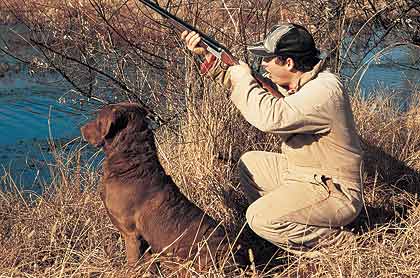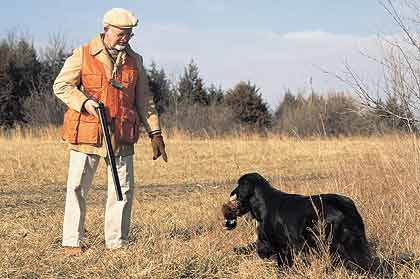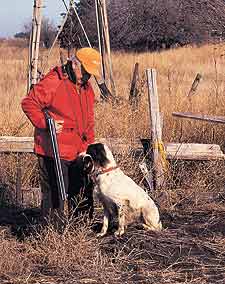...but then, so can most other sporting breeds
By James B. Spencer
Emerson was Right
James Lamb Free did the retriever world a great service by writing his classic, Training Your Retriever, which is not only an informative book about retrievers and their training, but also a masterpiece of enjoyable how-to literature, a real page-turner. I treat my own first edition copy with a reverence inspired by awe.
 When hunting over decoys, the blind can be quite simple if the background helps hide both the hunter and the dog. |
However, Mr. Free did the retriever world a disservice, and the spaniel world an injustice, by claiming that Labs can equal spaniels in the uplands. Granted, retrievers can do journeyman upland work. But to see a master at it you need to follow an FC English springer, English cocker, or American cocker through a few fields.
In 1985, at the first AKC retriever hunting test, I had an irresistible opportunity to disabuse all hands of any notion of retriever/spaniel equality in the uplands. Back then, the master level (which I was judging) included an upland flushing series. So I had Chad Betts run one of his field-trial springers as test dog in that series.
Wow! What a show! Compared to the work of that little bundle of slash and dash, the work of the best of the 25 entered retrievers was underwhelmingly ho-hum. I've never since heard anyone in attendance utter the previously often-uttered James Lamb Free "heresy" about retrievers equaling spaniels in the uplands. (In 1987, when judging the master level of an early AKC spaniel hunting test, I had Perry Overstake run his field-trial Lab as test dog in the water blind, with similar comparative results.)
So, when speaking of the versatility of retrievers, let's omit comparisons with other sporting breeds and focus on the abilities of retrievers. Ralph Waldo Emerson put it so well, with "Comparisons are odious." If you're happy with your retriever's work in the uplands, what difference does it make how he stacks up against spaniels?
Ditto if you hunt raccoon, or bear, or elephant with your retriever. If you refuse to be happy unless your pooch is at least the equal of all other pooches in whatever specialty, you're sentencing yourself to a life of either misery or delusion.
What is a Versatile Retriever?
Realistically, a versatile retriever should satisfy the canine equivalent of Cardinal Newman's definition of an educated person: One who knows a little about many subjects and a lot about one particular subject. For example, a truly educated doctor should know a little about law, business, history, literature, and so on, although his expertise is necessarily in medicine.
Applying that concept to retrievers, we would have to say that a versatile retriever excels in non-slip retrieving and does acceptable work in other types of hunting, especially flushing (or pointing, whichever the owner prefers) and retrieving the various species of upland gamebirds.
Non-Slip Retrieving
In non-slip retrieving, the dog remains at heel or in some designated place near the blind until sent to retrieve. This can involve both water and land work on waterfowl or driven upland gamebirds (as in English-style hunts).
We hunt ducks and geese in a variety of ways: over decoys from shoreblinds or boats; over decoys from field blinds; pass-shooting from a fixed location; and jump-shooting. In all of these, the retriever's job is the same: Remain at heel until sent to retrieve downed birds. Granted, in jump-shooting the dog is heeling in motion whereas in the other techniques he is stationary. Either way, he remains at heel until the birds are shot.
 Retrievers can do journeyman work in the uplands, as this flat-coat demonstrates in retrieving a pheasant. |
But after the shooting, the retriever may have quite a bit of "clean-up" work to do. Since waterfowl prefer to live and travel in flocks, each brief session of action in hunting them can result in several birds falling in various locations, at varying distances, and in various conditions.
Not surprisingly, those who developed our retriever breeds bred animals with excellent eyesight and memories, animals that can mark several falls and remember each one while retrieving them one at a time. Retrievers also have excellent noses and can trail cripples in water as well as on land. Therefore, a well-bred retriever has a very good chance of retrieving any bird the boss shoots, as long as he (the dog) sees it fall.
Up to this point, training a retriever is quite simple. You need merely steady the beast, cure him of switching and returning to old falls, and give him lots of experience in marking and remembering multiple falls.
But then, back in the 1920s, along came Dave Elliot with his "blind retrieve," in which the boss "handles" (directs) his retriever to a bird the dog didn't see fall. (The boss must know about where it is.) This allows a hunter with a properly trained retriever to recover many birds that would otherwise have gone un-retrieved. What a great improvement!
However, for the trainer, the blind retrieve offers two challenges: First, it cannot be bred into a dog, so must be totally trained; second, over the years, field trial judges have been gradually making competitive blind retrieves so difficult that training for them is practically a full-time job for both trainer and dog. Unfortunately, and also unnecessarily, these stem-winding blinds have overflowed into non-competitive hunting tests, so all dog-gamers must deal with them.
Actually, nothing else in the training of sporting breeds even approaches the time and ingenuity requirement necessary for training (and keeping trained) a dog-game retriever. I mention this because it impacts how much additional training such a retriever can absorb before his overload lights begin flashing.
Upland Gamebird Hunting
Should you train your retriever to do "flat-pattern" (windshield-wiper) quartering, like a spaniel? Unfortunately, such quartering and blind retrieve training somewhat contradict one another. In the blind retrieve, when sent away from you, your dog must run "real straight," whereas in quartering, when sent away from you, he must run "real crooked."
Can you teach your dog both? Probably. Awhile back, I so trained my English springer, Flick (Orion's Flicker MH), by using two precautions
:
 Flick, the springer that both quartered and did basic blind retrieves, delivers a pheasant to the author. |
First, I didn't start blind retrieve training until he was two years old and quite comfortable with quartering; second, I kept his blind retrieves short and basic, like Dave Elliot's original design, not like what you see today in retriever dog-games. If, in addition to all his regular spaniel training, I had pushed Flick into even moderately challenging blinds, his delightful spirit would have suffered irreparable damage.
I've never trained a retriever to do flat-pattern quartering, for the simple reason that it isn't necessary. In blind retrieve training, a retriever learns all he needs to know to "hunt to the gun" successfully in the uplands. By this, I mean the dog hunts within easy gun range of the hunter, flushes (or points, if you prefer) and retrieves birds. Here's how it works.
To start your dog hunting, you give him his release command, "Okay" (or whatever), which every dog should know. If he gets too far ahead, you stop him with the sit-whistle (a blind retrieve staple) and make him wait until you catch up, after which you release him to hunt again. If he swings too far to either side, you recall him with the come-whistle (another blind retrieve staple) and release him again as soon as he's back where he belongs.
If he's trailing a runner and gets too far away from you, you stop him with the sit-whistle, catch up, and then release him to continue trailing. You might occasionally stop your dog this way several times over a long distance and finally watch him flush a bird within 10 or 15 yards of you. Incidentally, when this happens, you'd better down that bird! Your dog has really earned that particular retrieve!
Frankly, I've never steadied a retriever to wing and shot in the uplands. After a flush, I've always let them break and chase. I can stop them from chasing a fly-away too far with the sit-whistle, so why not let them have a little fun? I'm strict enough with them in all non-slip retrieve training, both marks and blinds, so I lighten up and make upland hunting fun and games for them. (I'm not so kind with spaniels, because upland work is primary for them.)
If you wish, you can train your retriever to do flat-pattern quartering, provided that you wait until after he's really comfortable with his blind retrieve work. But why bother? It's not at all necessary, and it could take something out of your dog, something you'd miss.
Nota Bene:
Jim Spencer's books can be ordered from the Gun Dog Bookshelf: Training Retrievers for Marshes & Meadows; Retriever Training Tests; Retriever Training Drills for Marking; Retriever Training Drills for Blind Retrieves; Retriever Hunt Tests; HUP! Training Flushing Spaniels the American Way; and POINT! Training the All-Seasons Bird Dog.






